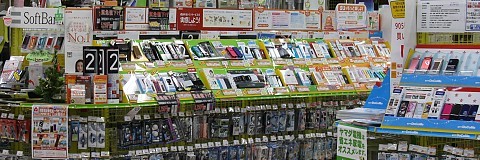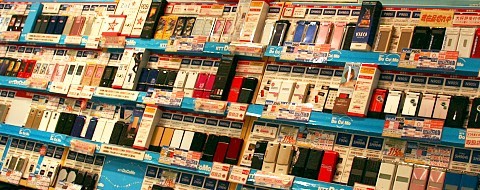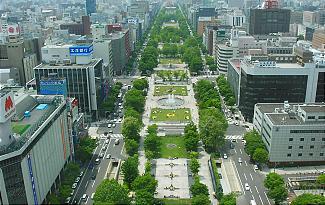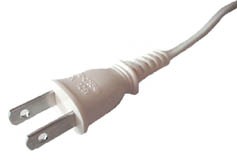Cell Phones in Japan
 |
| basic information |
 Mobile phone display racks at an electronics store.
Mobile phone display racks at an electronics store. Mobile phones
Japan is a leader in mobile phone technology and usage with about 75% of the population owning one. Mobile phones are everywhere, and they are constantly getting new features such as internet browsers, games, cameras, televisions, electronic wallets/train passes, gps/navigation and music players.
The biggest mobile phone companies in Japan are NTT Docomo, au by KDDI, and Softbank (formerly Vodafone, and before that J-phone). Docomo is the most popular company with about 50 million subscribers. Au is next with about 30 million subscribers, while Softbank has about 15 million subscribers..
Do foreign phones work in Japan?
Due to different technologies, mobile phones from your home country may not work in Japan. Most importantly, there is no GSM network, so GSM phones do not work. There are two things that are required for your telephone to work:
- Compatibility with the Japanese mobile phone network - The only foreign phones that work in Japan are some 3G models, however the number of compatible phones is increasing. Contact your service provider for details concerning your particular phone.
- International roaming plan or rental SIM card - With an international roaming plan (from your home service provider) you use your own phone and number, but are charged international roaming rates which tend to be expensive. Alternatively, with a rental SIM card (from a Japanese provider) you use your own phone with a Japanese phone number and lower rates.
Do Japanese phones work outside of Japan?
The majority of Japanese phones will not work overseas due to network differences; however, there are phones available that can operate on 3G and GSM networks (only in certain countries) with the appropriate international roaming plans, although while overseas some of their advanced functions will likely not work.
Generally speaking it is not possible to use a Japanese phone with a foreign service provider because most do not use SIM cards and the few that do are locked and are difficult (if not impossible) to unlock. Also, Japanese phones are designed at a hardware and software level to work with only a particular service provider. As a result they are not interchangeable even between Japanese service providers.
 There are phones to suit every style, but the display phones are non-working plastic samples.
There are phones to suit every style, but the display phones are non-working plastic samples. How to get a mobile phone:
Rental Phones
Renting is the most economical way for the average traveler to get a phone, and typically requires a picture ID and a credit card. Many companies have kiosks at the airports, while other companies will mail a phone to your hotel or to your home. You can return the phones at the airport or through the mail depending on the company.
The fees for rental phones vary and usually consist of the rental fee (typically 250-1000 yen per day) plus a usage fee (typically 70-200 yen per minute domestic outgoing, incoming calls are free). All of the companies at the airports have same day rentals, while some companies offer discounts for advanced reservations.
Prepaid Phones
Due to past criminal abuse of prepaid phones, phone sellers must now verify the identity and place of residence of their buyers. Typical proof can be in the form of a Japanese driver's license, a Japanese Passport, or an alien registration card. Some stores will accept foreign passports along with a hotel address as verification.
Prepaid phones start around 5000 yen. Credit, which is used for outgoing calls, email, internet, etc. depending on what features your phone supports, must be purchased in advance. With most companies, incoming calls are free and outgoing calling rates are comparable to those of rental phones.
Credit can be bought at cell phone stores and convenience stores and is typically valid for two months. Phone numbers remain active as long as you have valid credit in your account, but will expire after four months to a year without use.
Subscription Plans
With subscription plans you pay for your usage at the end of a monthly billing cycle as opposed to prepaid phones where you buy your usage before you use it. The phones themselves can be free although that typically requires a 2 year contract.
All the latest and most advanced phones are available with subscription plans and the selection of handsets is huge. Subscription plans are only available to residents and require an alien registration card and a Japanese bank account.




